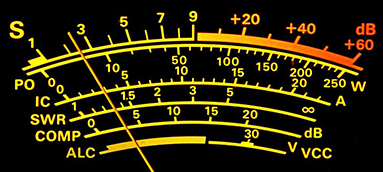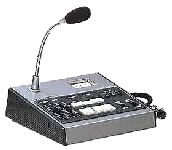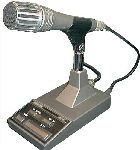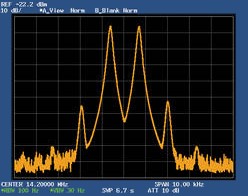|
Technical
corner
|

|
|
The
mechanical VU-meter used in some Yaesu transceivers. |
Check
your transmitter power
In
the past many amateurs had in their shack a 50-ohm dummy load, an external
wattmeter and an oscilloscope to get accurate measurements of signals emitted
by their transmitter. Today with the electronic revolution, many of these
accessories disappeared from most new hamshacks. They are useless as some
RTX provide them built-in. But rare are radios equipped with an oscilloscope! So,
without checking are you sure of your digital VU-meter accuracy ? How to know if your
transmitter delivers the rated emitting power if all amateurs give you a
"59" inside a radius of 8000 km around your QTH ?
It
is interesting to answer to that question because it is always
frustrating to buy an radio delivering 100 W PEP but that
practically transmits less than half that power in peak SSB to the
antenna. But there
is not really advantage of doing a hardware modification at the
audio (microphone circuit) to increase its power and reach these 100
W in SSB if the mike circuit is capable of fully driving your radio.
The circuit of modern RTX is surely capable. All you will end up
doing is adding distortion, lowering the setting you keep on your
mike gain, and produce more QRM of bands... Some do, but a good
amateur radio shouldn't.
On another side, are you sure that your antenna system receives well
all the power of your last stage ?
If
you have a second transceiver you can already make some measurements
in working both exactly in the same conditions, switching from one
to the other several times and asking your correspondant a QRK or a
true RST report.
But
nothing can resist to the accuracy of an electronic measurement,
using an external SWR-meter or better, an oscilloscope.
Take
the opportunity of this test to review the functioning of both
instruments and their limitations in measuring the true emitting
power of your transmitter.
SWR-meters
SWR-meters
and wattmeters display various accuracies, some display the average power,
others the peak PEP. Some are active some passive, others use a
digital or an analog reading using one needle or two
crossed-needles, this latter model being the most appreciated. At last
more and more models can display both values, average and peak values thanks to
a switch, as well as the forward and reflected power, and the SWR simultaneously.
So check well in which mode is set yours before a reading.
Among
all models of SWR-meters available on the place, very few are
good at giving an accurate reading of voice peaks because the
meter movements are too slow. If someone sees the full 100 W
on SSB, (s)he either has an excellent peak reading meter,
or (s)he is overdriving his or her radio. I'd say that the
majority are unfortunately concerned by the second method.
With
"normal" drive, I mean an average speach, you will
usually see only about 40 watts on an average meter when doing
100 W PEP out. This is normal when we know how work SSB !!!
Even don't try to pump up the gain to get more reading. You
will just overdrive and shorten the live time of your RTX.
Passive
peak SWR-meters are always slow, sluggish, and never read
the full actual output. Most will average about 80 W peaks,
when you transmit an actual 100 W peaks ! All they are doing
is adding a small electrolytic cap to the meters to give some
"hang time". Forget this model.
This
being said, today most passive SWR-meters and wattmeters display an
error margin within 3-10%, reasonable for their price. They are of
course not laboratory grade instruments that cost up to thousand
dollars and more.
Then
you have active peak SWR-meters. These will be the most
accurate, using an electronic circuit that amplifies the reading
before display. But they are always unable to read a gospel voice !
If you can adjust your microphone gain and be within the normal ALC
specs for that radio, you have enough mike drive. Most if not all
modern RTX respect this way of working.
If
you can whistle hard into the mike, and get nearly 100 W on the
meter, you have enough mike drive. Don't worry about what you read
on SSB and if you lack some watts of power. If you are doing 100 W in CW, you should be doing it on SSB
too and other modes (excepting AM that will reach 25 W by design),
within the error margin of your meter.
Take
another example. If I run 1 kW out of my linear amplifier, I usually see only
about 300 W on average meter voice peaks. You don't think
that my voice peaks are really 1 kW ? Go out and grab the
end of my antenna when I emit... I am 100% confident that you will get
back to me after the paramedics wake you up and probably
bandaged your injuries at hands ! (for the readers who don't
know this effect yet, know that the energy - and current -
flowing in a 1 kW antenna is able to shock you.
So in emission do never
touch an antenna, neither its radials nor the dipole. Its
ends can also burn if they are in contact with the ground or
create a short-circuit if the PL connectors are wet).
Now
the bottom line. According to some advanced hams, very, very
few wattmeters or SWR-meters are worth to be acclaim at measuring SSB
voice peaks. If you are concerned by this so-called problem
you are worrying about an issue that probably doesn't really
exist. Well, unless case you do have a radio problem, but this
is rather rare. In case of doubt you can ask your dealer to verify
the power of your RTX in all modes. That will cost you a hour of
labor by a radio engineer or about 50 euros.
To
read : SWR, the radiation resistance
And
if my microphone was faulty ?
Most
all radios are set up from the factory to have the mike controls
match the stock mikes. So if you use the stock hand mike, or stock
desk mike, the microphone gain controls "should" end up
being set in the middle range of the mike gain control (usually set
to "50" on a Kenwood TS-570D or to "5" on an
Icom IC-706 which is halfway in both cases). This is the way you
want your mike set up. So if you add on extra mikes, you will have
to adjust the gain to match what you have, and let the radio be in
the middle of its range for gain.
How
to adjust mike gain while talking ? Mark Keith, alias NM5K, give us a method
which seems fairly accurate. Set up your transceiver into a dummy load, and
set its power output for 100 W "full power". Use an average SWR-meter,
or if this is a peak meter set it to "average" (RMS).
Then
set the mike gain at its lowest setting. Then speak into the mike in
your normal volume, and say "x-ray" a couple of times at
the lowest mike setting. Then adjust the mike gain up a notch at a
time, and say "x-ray" again a couple of times while on
each increasing setting of mike gain. When you get to the point
where increasing the gain makes no change on the indicated wattmeter
reading, you have full mike drive. I bet that if you try this on
your radio, you will end up near the half way mark on your mike
drive when using a stock mike.
|

|

|
|
You
can get a modulation a bit stronger very useful to
work pile-ups or in heavy QRM conditions using an active electret microphone
(using a small battery) instead of a dynamic model. At left the MC-85 electret
model from Kenwood compared to its challenger the
dynamic mic MC-60. They are not all suited to all
transceivers and you have to check the manufacturer
catalog of accessories to find the model recommended
to your TX. On the other hand both technologies are
available for hand-held microphones too. Documents from the
manufacturer. |
|
When
you get to the point where you have no change, set it back to the
first setting that gave the maximum reading, and you are pretty dang
close to the proper setting. Watching a scope while doing this is
even better, but this method is intended for non-scope users. And
yes, being this is an average meter being used, you will likely only
see voice peaks less than 40 watts or so, depends on the voice. If you
add a preamp to a normal mike circuit, you will overdrive your RTX
own circuit, and end up at "1" as far as your mike
setting. Will make it real touchy, and easy to overdrive.
If
you did the "x-ray" test, and could go all the way to the
end of the mike gain, and were still seeing increasing average
power, and show no signs of clipping at all, it is then possible
that you would need a preamp to get your full power. It will be
fairly obvious power is down from normal, once you get used to what
normal should look like on your particular meter. You can also do a
hard whistle test...
Note
that many old radios (Icom, Yaesu, over 10 years old) needed
outboard mike preamps. Also be aware that radios will read different
due to audio frequencies differences also.
The
bottom line... If you see a point of no increase when adjusting, as
when "normal", there is no point in adding any preamps.
And also no point in worrying what a particular meter reads on voice
peaks unless it is radically off from normal. The meter movements
just can't keep up.
By
way of conclusion, misunderstanding SWR-meter or wattmeter action and how
microphones and their features work is very common among newer
amateurs. It is why many overdrive, when they really are not intending to.
They are fooled by those dang blasted SWR-meters or those mikes more
or less excited...
The
problem can however happen when your old transceiver transmits all its power
and not your new model for an unknown reason. In this particular
case, there is of course something different between both rigs. Most
of the time this is probably an undocumented setting in a secundary
menu that has to be changed on your new RTX. In the worst case you
have to make an hardware modification on the audio circuit (e.g. for
the Kenwood TS-570D serie, here are the audio block and
schematic to modify) or
more softly, you can modify settings in the main or servicing menu of
your RTX. But most hams will never recommend you to make any hardware operation on a new radio.
Now
there is a better alternative to measure your power : this is using
an oscilloscope. Here is a good way to check the situation, which would
make it clear whether your transmitter is actually delivering its rated
power or not without risk of error.
Procedure
to measure your actual power
After
this long technical interlude, let's verify the emitting power of
your transceiver. What you will need to do is to hook the transmitter to the external wattmeter,
then to an oscilloscope, and then to a 50-ohm dummy load. You might
be able to just use a BNC "T" adapter to connect the feedline to
the scope input (you would need an input which can accept signal levels
of 70-100 volts RMS).; If your scope can't tolerate this high a
voltage level, figure out some way to use a standard 10:1 probe to sample
the RF voltage... perhaps at one of the wattmeter connectors, or via a
short SO-239/PL-259 pigtail which exposes the coax connectors for a
fraction of an inch.
To read:

How
to use an Oscilloscope
Set
the oscilloscope in self-triggering mode (so that it will continually
sweeping) with a sweep rate of 50-60 Hz or so.
Set
the input sensitivity so that scope will read full-scale for a
signal of about 100 volts RMS (which would be 144 volts peak, or a
total of 288 volts peak-to-peak). If you have used a 10:1 probe,
setting the scope to 5 volts per vertical division would be about
right.
Set
the transmitter for 100 W output, CW mode, and key it. The scope
should display an RF envelope (it will probably display as a solid glare)
which is about 3/4 of full scale on the display (70.7 volts into 50 ohms
equals 100 W). Both your transmitter meter and your external
wattmeter should now display 100 W, plus or minus their calibration
tolerances.
Make
a note of the vertical position of the signal on the scope. If you
wish, crank the gain up or down so that full CW power results in
full-scale vertical deflection of the scope.
Now,
un-key the transmitter, switch to SSB, key the mike, and start talking.
What
you would hope to see, if the transmitter is working properly, is
that the display on the scope jumps up to full-scale (matching the
maximum deflection on CW) when you speak loudly into the microphone. At
lower voice levels, it will deflect less than full scale, probably
between 20-50 W for a 100 W PEP transceiver.
If
speaking strongly into the microphone delivers full-scale vertical
deflection, then your tranmitter is delivering 100 W of peak power
(plus or minus the calibration error), and there is nothing wrong with it.
Half-scale
vertical deflection would be 25 W. Quarter-scale would be about
6 W; you are QRP !
Most
of the time your emitting power, whatever the mode (FM, FSK, CW,
USB, LSB) must be around the PEP value more or less 5-8%. Of
course in AM, by design you cannot transmit more than 25 W for a 100
W PEP SSB emitter.
The
procedure is easy to set up and to follow. In case of problem or if
your transmitter has to be servicing for one reason or another, do
not hesitate to ask the technical staff of your manufacturer to make
a test and to provide you the numbers for each band and mode as I
did with my TS-570D.
I hope that
this procedure will help you in your diagnostic.
I
warmly thanks Dave Platt, AE6EO, for his technical expertise.
For
more information
Tektronix
(oscilloscope software)
Tektronix
storage oscilloscope
Picoscope
(oscilloscope simulator to download)
Back
to Menu
|